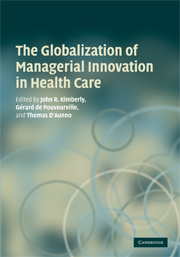Book contents
- Frontmatter
- Contents
- List of figures
- List of tables
- List of contributors
- Acknowledgements
- Introduction
- 1 Origins of DRGs in the United States: A technical, political and cultural story
- 2 Casemix in the United Kingdom: From development to plans
- 3 Casemix implementation in Portugal
- 4 From naïve hope to realistic conviction: DRGs in Sweden
- 5 Casemix in Denmark
- 6 DRGs in France
- 7 Introduction and use of DRGs in Belgium
- 8 DRGs in Germany: Introduction of a comprehensive, prospective DRG payment system by 2009
- 9 Casemix in Switzerland
- 10 The first decade of casemix in Italy
- 11 Casemix development and implementation in Australia
- 12 Diagnosis procedure combination: The Japanese approach to casemix
- 13 Casemix in Singapore
- 14 Experiences with the application of the DRG principle in Hungary
- 15 Casemix systems – past, present, and future: The Canadian experience
- 16 Conclusions: The global diffusion of casemix
- Index
- References
6 - DRGs in France
Published online by Cambridge University Press: 24 February 2010
- Frontmatter
- Contents
- List of figures
- List of tables
- List of contributors
- Acknowledgements
- Introduction
- 1 Origins of DRGs in the United States: A technical, political and cultural story
- 2 Casemix in the United Kingdom: From development to plans
- 3 Casemix implementation in Portugal
- 4 From naïve hope to realistic conviction: DRGs in Sweden
- 5 Casemix in Denmark
- 6 DRGs in France
- 7 Introduction and use of DRGs in Belgium
- 8 DRGs in Germany: Introduction of a comprehensive, prospective DRG payment system by 2009
- 9 Casemix in Switzerland
- 10 The first decade of casemix in Italy
- 11 Casemix development and implementation in Australia
- 12 Diagnosis procedure combination: The Japanese approach to casemix
- 13 Casemix in Singapore
- 14 Experiences with the application of the DRG principle in Hungary
- 15 Casemix systems – past, present, and future: The Canadian experience
- 16 Conclusions: The global diffusion of casemix
- Index
- References
Summary
France, with its population of around 62 million, is one of the largest countries in the EU, first by geographic size and second, after Germany, by population. US DRGs were introduced into France as GHM (Groupes Homogène de Malades) as early as 1983, but they weren't used as a resource allocation tool until 1997, and had no major impact until 2004. This project, called PMSI (Programme de Médicalisation des Systèmes d'Information), has been shaped by the fragmented design of the French health care system and by the cultural framework embedding socio-economic reform in France.
A brief description of the French health care system
Ranked the number one health care system in the world by the World Health Organization in 2000, the French health care system provides a high level of service, but at what could be considered a very high price when compared to many other OECD countries.
Hospital care is characterized by the coexistence of public, private for-profit, and private not-for-profit hospitals, whose ownership, organization, management and financing differ widely.
Core indicators
The French population enjoys a good health care status and benefits and easy accessibility (despite geographic inequalities) to the entire health care system. However, the cost of this system, and therefore its tendency to increase deficits, has been a major issue in public debates for over three decades.
Satisfaction with the French health care system is traditionally high – much higher than in most other countries.
- Type
- Chapter
- Information
- The Globalization of Managerial Innovation in Health Care , pp. 116 - 143Publisher: Cambridge University PressPrint publication year: 2008
References
- 3
- Cited by



